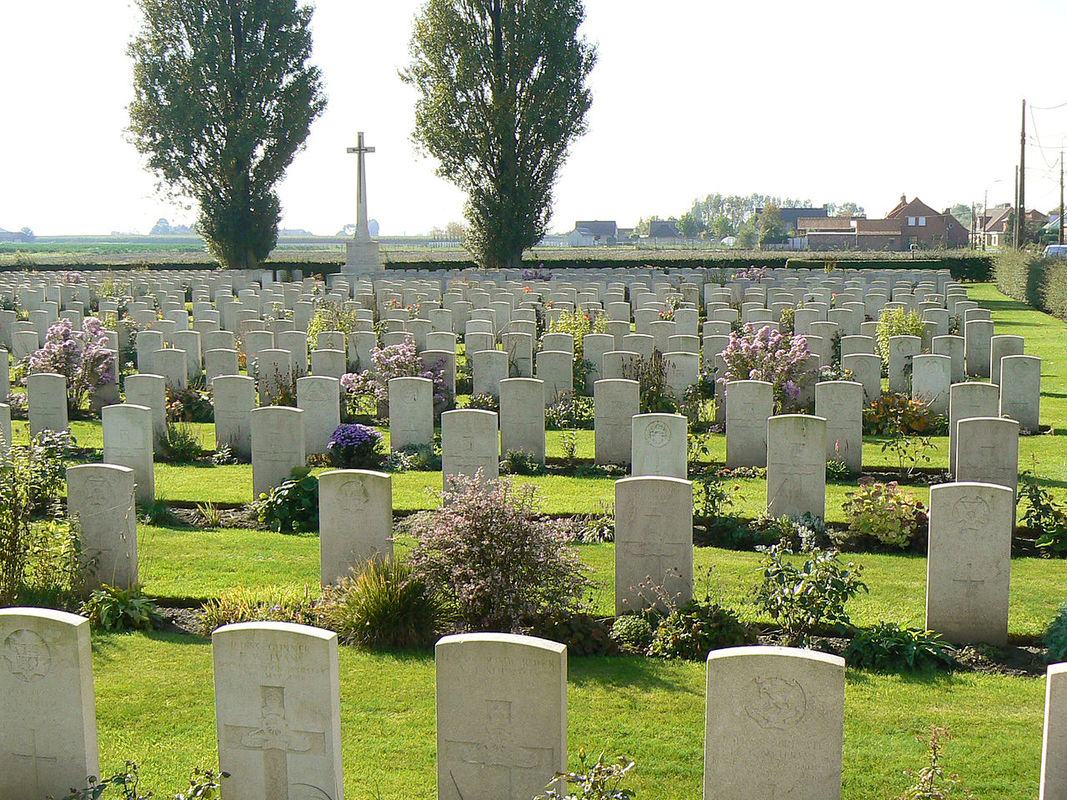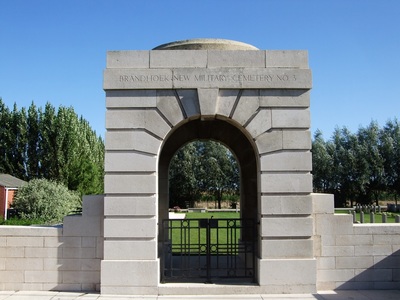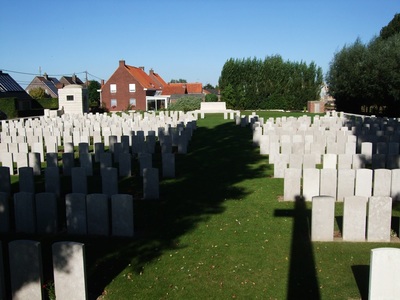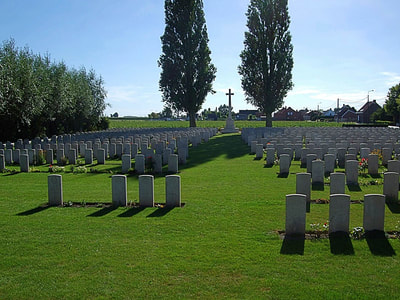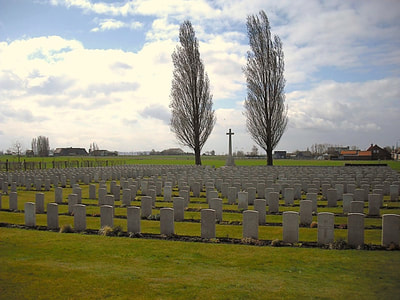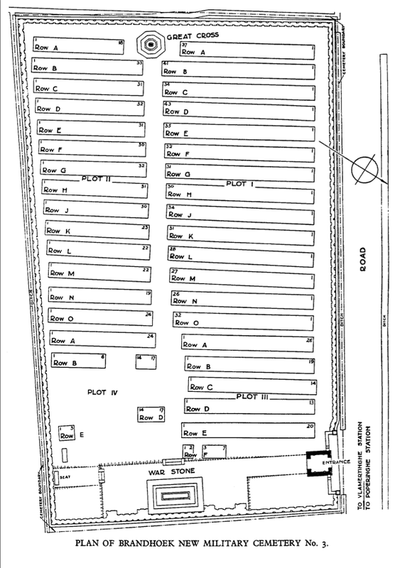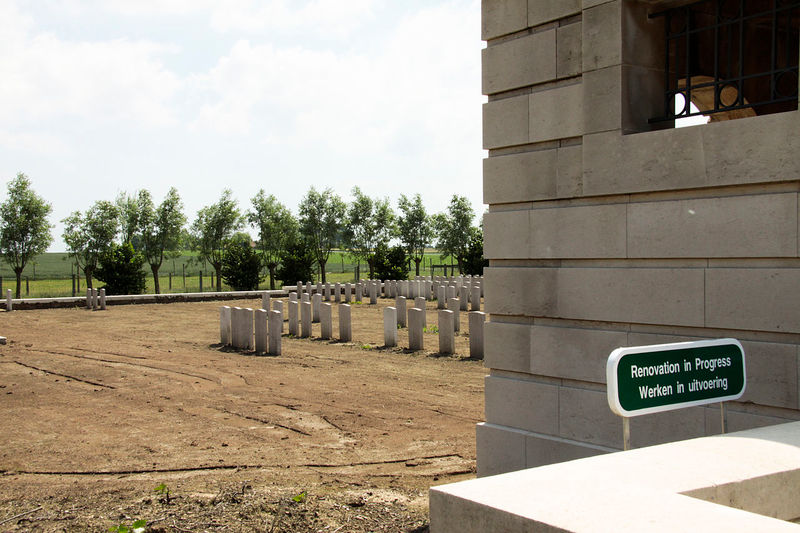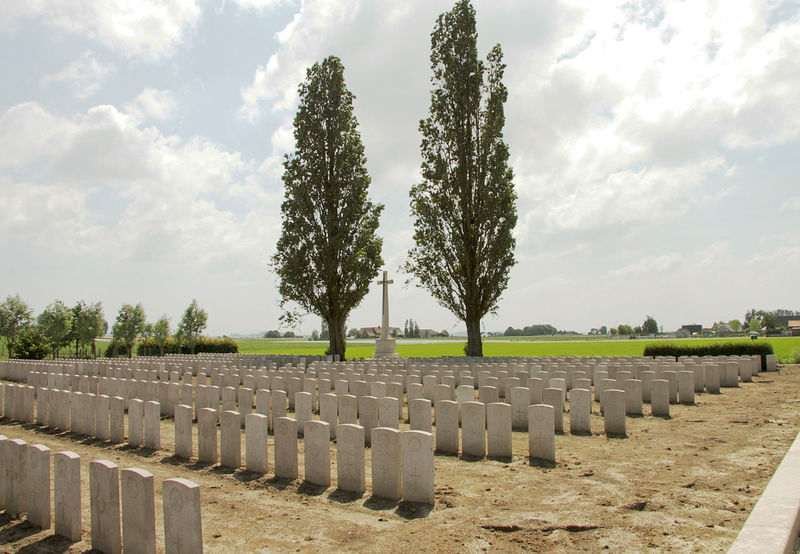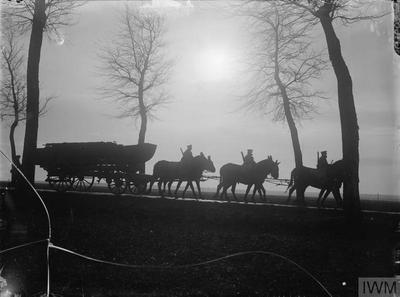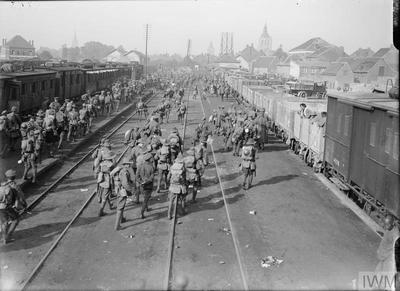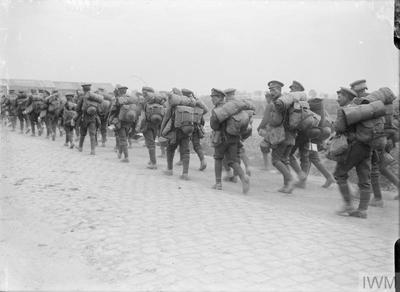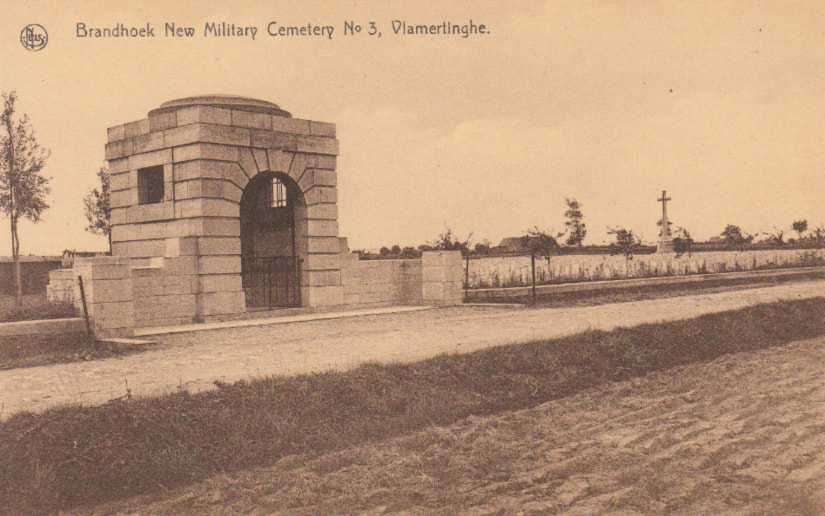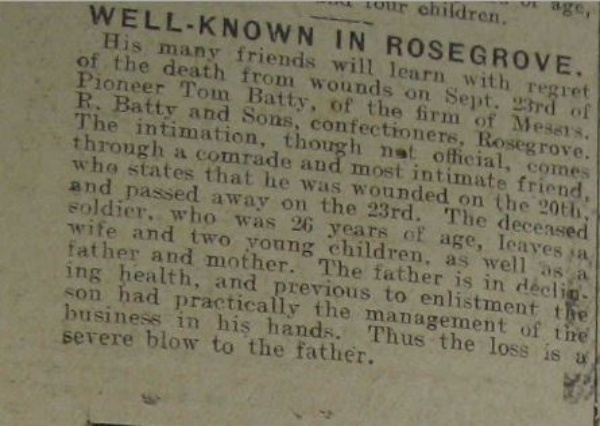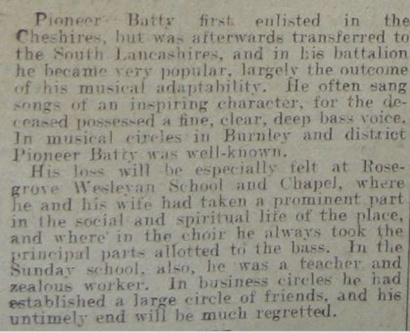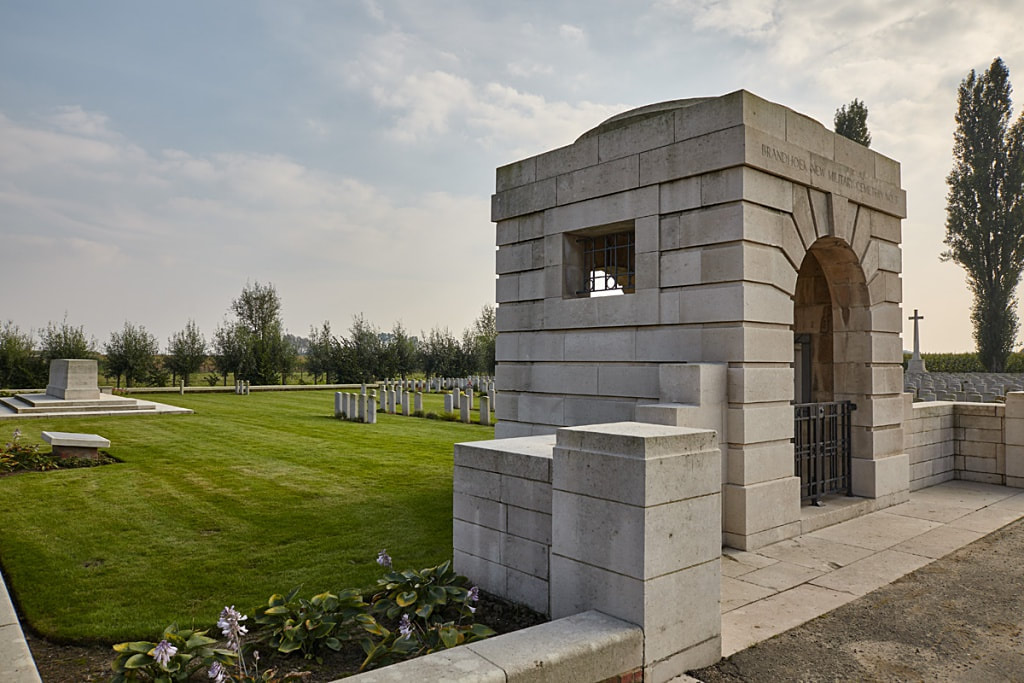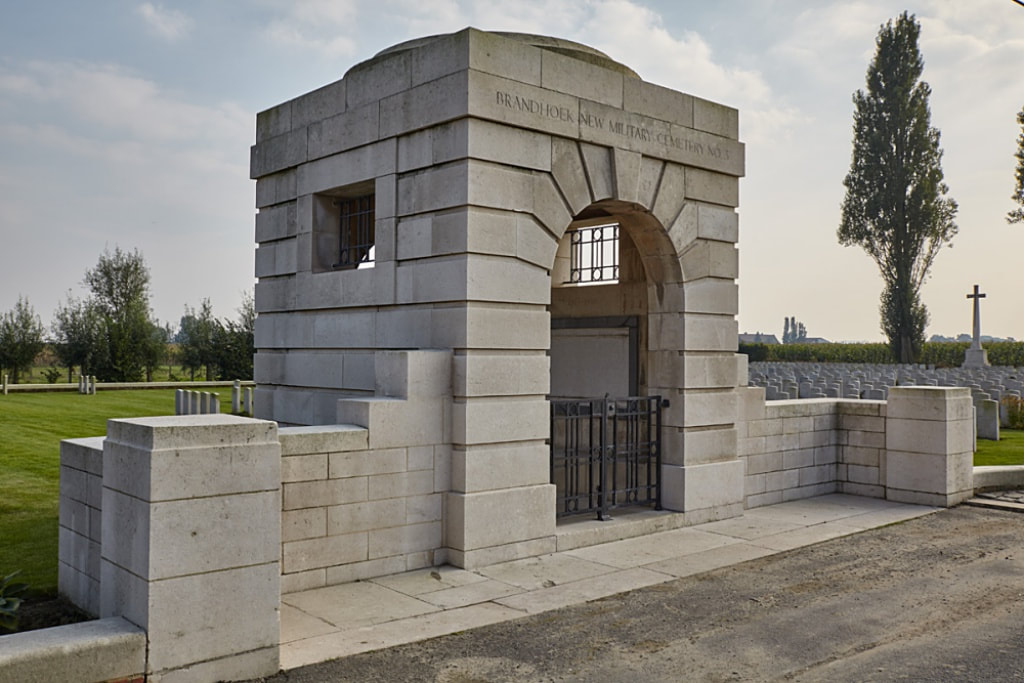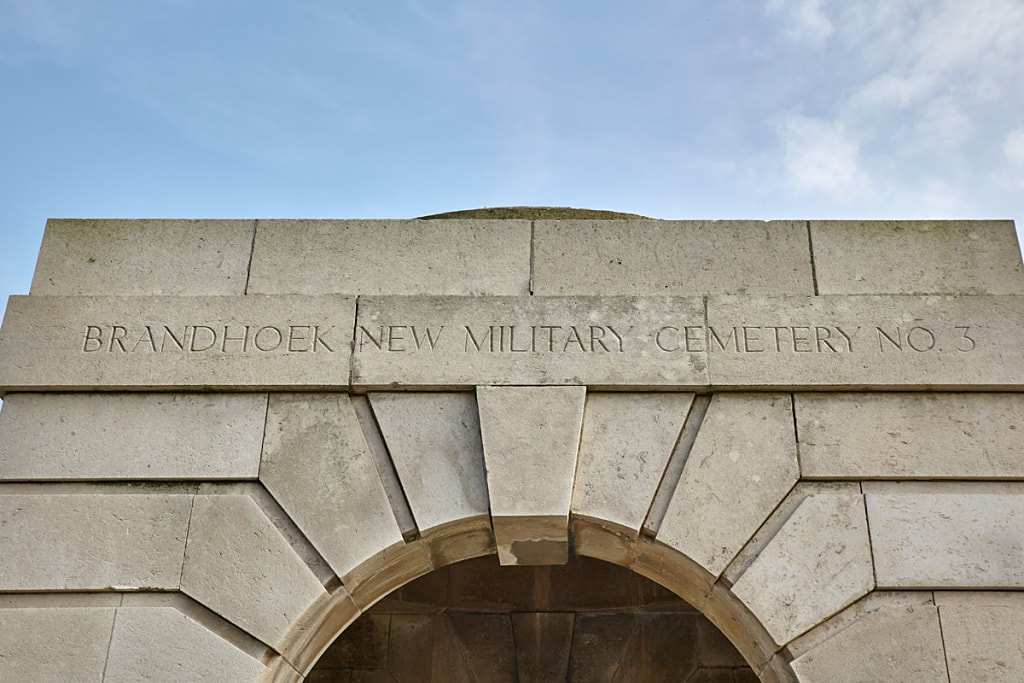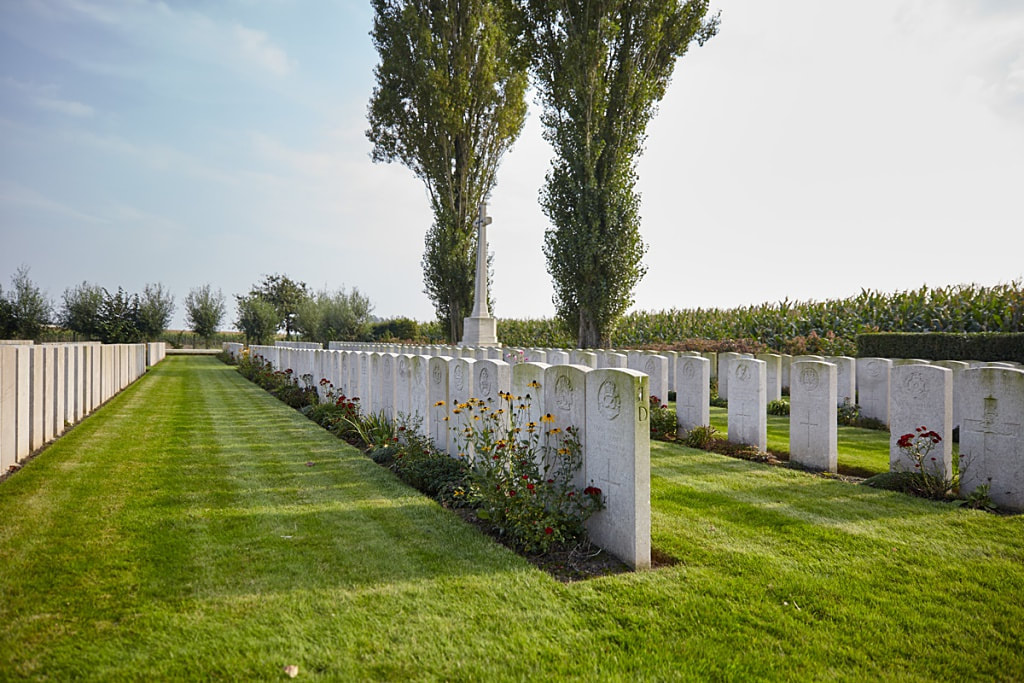BRANDHOEK NEW MILITARY CEMETERY No. 3
West-Vlaanderen
Belgium
GPS Coordinates Latitude: 50.85218 Longitude: 2.78782
Location Information
Brandhoek New Military Cemetery No 3 is located 6.5 km west of Ieper town centre, on the Zevekotestraat, a road leading from the N308 connecting Ieper to Poperinge.
From Ieper town centre the Poperingseweg (N308), is reached via Elverdingestraat then directly over two small roundabouts in the Capronstraat. The Poperingseweg is a continuation of the Capronstraat and begins after a prominent railway level crossing.
6 km along the N308, after passing the village of Vlamertinge and just beyond the church in the hamlet of Brandhoek lies the left hand turning onto the Grote Branderstraat. After crossing the N38 Westhoekweg, the first right hand turning leads onto the Zevekotestraat. The cemetery is located 300 metres along the Zevekotestraat on the left hand side of the road, beyond the N38 dual carriageway, which it is necessary to cross.
Visiting Information
The location or design of this site makes wheelchair access impossible.
Historical Information
During the First World War, Brandhoek was within the area comparatively safe from shell fire which extended beyond Vlamertinghe Church. Field ambulances were posted there continuously.
Until July 1917 burials had been made in the Military Cemetery, but the arrival of the 32nd, 3rd Australian and 44th Casualty Clearing Stations, in preparation for the new Allied offensive launched that month, made it necessary to open the New Military Cemetery. The New Military Cemetery No 3 opened in August and continued in use until May 1918.
Brandhoek New Military Cemetery No 3 contains 975 First World War burials.
Total Burials: 975.
Identified Casualties: United Kingdom 850, Canada 54, Australia 46, New Zealand 18, South Africa 5. Total 973.
The cemetery was designed by Sir Reginald Blomfield and Noel Ackroyd Rew
Dedications
Second Lieutenant Samuel Levis Trinder, 9th Bn. Royal Irish Fusiliers, 17th August 1917, aged 36.
Remembered by Alexis Bolster and Albert Duke
Brandhoek New Military Cemetery No 3 is located 6.5 km west of Ieper town centre, on the Zevekotestraat, a road leading from the N308 connecting Ieper to Poperinge.
From Ieper town centre the Poperingseweg (N308), is reached via Elverdingestraat then directly over two small roundabouts in the Capronstraat. The Poperingseweg is a continuation of the Capronstraat and begins after a prominent railway level crossing.
6 km along the N308, after passing the village of Vlamertinge and just beyond the church in the hamlet of Brandhoek lies the left hand turning onto the Grote Branderstraat. After crossing the N38 Westhoekweg, the first right hand turning leads onto the Zevekotestraat. The cemetery is located 300 metres along the Zevekotestraat on the left hand side of the road, beyond the N38 dual carriageway, which it is necessary to cross.
Visiting Information
The location or design of this site makes wheelchair access impossible.
Historical Information
During the First World War, Brandhoek was within the area comparatively safe from shell fire which extended beyond Vlamertinghe Church. Field ambulances were posted there continuously.
Until July 1917 burials had been made in the Military Cemetery, but the arrival of the 32nd, 3rd Australian and 44th Casualty Clearing Stations, in preparation for the new Allied offensive launched that month, made it necessary to open the New Military Cemetery. The New Military Cemetery No 3 opened in August and continued in use until May 1918.
Brandhoek New Military Cemetery No 3 contains 975 First World War burials.
Total Burials: 975.
Identified Casualties: United Kingdom 850, Canada 54, Australia 46, New Zealand 18, South Africa 5. Total 973.
The cemetery was designed by Sir Reginald Blomfield and Noel Ackroyd Rew
Dedications
Second Lieutenant Samuel Levis Trinder, 9th Bn. Royal Irish Fusiliers, 17th August 1917, aged 36.
Remembered by Alexis Bolster and Albert Duke
Images in this gallery © Werner Van Caneghem

235263 Private
Tom Batty
1st/4th Bn. South Lancashire Regiment
20th September 1917, aged 26.
Plot I. F. 22.
Husband of Ada Batty, of Rosegrove, Burnley.
His headstone bears the inscription; "A Loving Husband, A Noble Son."
Tom Batty
1st/4th Bn. South Lancashire Regiment
20th September 1917, aged 26.
Plot I. F. 22.
Husband of Ada Batty, of Rosegrove, Burnley.
His headstone bears the inscription; "A Loving Husband, A Noble Son."

2906 Private
Arthur Ernest Charles Baker
42nd Bn. Australian Infantry, A. I. F.
12th October 1917, aged 21.
Plot II. L. 21.
Son of Arthur Benjamin and Mary Ann Baker. Born Grafton, New South Wales.
A labourer prior to enlisting in October 1916, Pte Baker embarked from Sydney with the 6th Reinforcements on board HMAT Demosthenes (A64) on 23 December 1916. After further training in England he arrived in France for service on the Western Front in July 1917. Pte Baker was killed in action by shell fire at Passchendaele, Belgium, on the morning of 12 October 1917.
Arthur Ernest Charles Baker
42nd Bn. Australian Infantry, A. I. F.
12th October 1917, aged 21.
Plot II. L. 21.
Son of Arthur Benjamin and Mary Ann Baker. Born Grafton, New South Wales.
A labourer prior to enlisting in October 1916, Pte Baker embarked from Sydney with the 6th Reinforcements on board HMAT Demosthenes (A64) on 23 December 1916. After further training in England he arrived in France for service on the Western Front in July 1917. Pte Baker was killed in action by shell fire at Passchendaele, Belgium, on the morning of 12 October 1917.
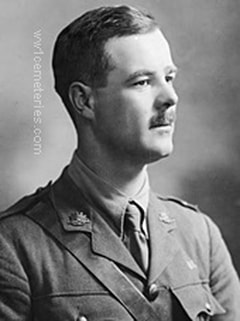
Major
Fred Leslie Biddle, D. S. O.
2nd Brigade, Australian Field Artillery
17th August 1917, aged 31.
Plot II. B. 25.
Son of James and Helena Isabel Biddle, of 92, Vale St., East Melbourne, Victoria, Australia.
His headstone bears the inscription; "Dearly Loved Son Of James & Helena I. Biddle Of East Melbourne."
A soldier, of East Melbourne, Victoria, prior to the war, he served for 10 years in the Australian Field Artillery where he was commissioned on 20 October 1910 and promoted to Captain (Capt) on 1 September 1913. At the outbreak of war Capt Biddle was commissioned in the 2 FAB and embarked from Melbourne aboard HMAT Shropshire for Gallipoli. The unit was withdrawn to Egypt in December 1915 and subsequently relocated to the Western Front, France, in March 1916. He was promoted to Major on 12 March 1916. He was awarded the Distinguished Service Order on 4 October 1916 for conspicuous gallantry over a three day period in July 1916 at the Battle for Pozieres during which he was wounded for the first time. Maj Biddle was repatriated to England for treatment and rehabilitation before rejoining the 2 FAB as temporary commanding officer on 25 September 1916. He was Mentioned in Despatches for distinguished and gallant services and devotion to duty in the field during November 1916. Maj Biddle was wounded a second time on 16 August 1917 and died of these wounds the following day at No 32 Casualty Clearing Station, Belgium.
Fred Leslie Biddle, D. S. O.
2nd Brigade, Australian Field Artillery
17th August 1917, aged 31.
Plot II. B. 25.
Son of James and Helena Isabel Biddle, of 92, Vale St., East Melbourne, Victoria, Australia.
His headstone bears the inscription; "Dearly Loved Son Of James & Helena I. Biddle Of East Melbourne."
A soldier, of East Melbourne, Victoria, prior to the war, he served for 10 years in the Australian Field Artillery where he was commissioned on 20 October 1910 and promoted to Captain (Capt) on 1 September 1913. At the outbreak of war Capt Biddle was commissioned in the 2 FAB and embarked from Melbourne aboard HMAT Shropshire for Gallipoli. The unit was withdrawn to Egypt in December 1915 and subsequently relocated to the Western Front, France, in March 1916. He was promoted to Major on 12 March 1916. He was awarded the Distinguished Service Order on 4 October 1916 for conspicuous gallantry over a three day period in July 1916 at the Battle for Pozieres during which he was wounded for the first time. Maj Biddle was repatriated to England for treatment and rehabilitation before rejoining the 2 FAB as temporary commanding officer on 25 September 1916. He was Mentioned in Despatches for distinguished and gallant services and devotion to duty in the field during November 1916. Maj Biddle was wounded a second time on 16 August 1917 and died of these wounds the following day at No 32 Casualty Clearing Station, Belgium.

1647 Driver
William Dutton
2nd Anti-Aircraft Sub. Park D. Australian Field Artillery
21st August 1917
Plot I. D. 2.
A motor driver from Brisbane, QLD, Dvr Dutton embarked with the 301st (Mechanical Transport), 8th Company, Army Service Corps (17th Divisional Ammunition Park) on 22 December 1914 aboard HMAT Ceramic (A40). He was later transferred to the 2nd Ammunition Sub Park, Australian Field Artillery. On 20 August 1917 whilst transporting ammunition to Hell Fire Corner along the Ypres-Menin Road, Dvr Dutton's lorry was hit by a shell. He was recovered from the wreckage and transferred to the 44th Casualty Clearing Station where he died from wounds on 21 August 1917. His friend, 149 Dvr Oliver William Woolfrey, was also killed in the explosion and is buried at the Menin Road South Military Cemetery.
William Dutton
2nd Anti-Aircraft Sub. Park D. Australian Field Artillery
21st August 1917
Plot I. D. 2.
A motor driver from Brisbane, QLD, Dvr Dutton embarked with the 301st (Mechanical Transport), 8th Company, Army Service Corps (17th Divisional Ammunition Park) on 22 December 1914 aboard HMAT Ceramic (A40). He was later transferred to the 2nd Ammunition Sub Park, Australian Field Artillery. On 20 August 1917 whilst transporting ammunition to Hell Fire Corner along the Ypres-Menin Road, Dvr Dutton's lorry was hit by a shell. He was recovered from the wreckage and transferred to the 44th Casualty Clearing Station where he died from wounds on 21 August 1917. His friend, 149 Dvr Oliver William Woolfrey, was also killed in the explosion and is buried at the Menin Road South Military Cemetery.

Second Lieutenant
John (Jack) Frederick Eberli
3rd Bn. attd. 2nd Bn. Royal Irish Rifles
16th August 1917.
Plot II. D. 1
Picture courtesy of Dennis Shelford
John (Jack) Frederick Eberli
3rd Bn. attd. 2nd Bn. Royal Irish Rifles
16th August 1917.
Plot II. D. 1
Picture courtesy of Dennis Shelford
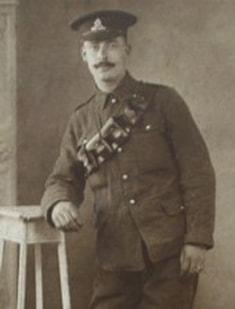
153875 Gunner
William Alfred Hook
Royal Horse Artillery, attd. "D" Battery, 71st Bde. Royal Field Artillery
23rd August 1917.
Plot II. D. 5.
Son of the late Charles and Jane Hook, of London; husband of Mrs. V. F. Hook, of 23, Gordon Rd., Stoke Newington, London.
His headstone bears the inscription; "Greater Love Hath No Man Than This."
Picture courtesy of Stephen Hook, grandson.
William Alfred Hook
Royal Horse Artillery, attd. "D" Battery, 71st Bde. Royal Field Artillery
23rd August 1917.
Plot II. D. 5.
Son of the late Charles and Jane Hook, of London; husband of Mrs. V. F. Hook, of 23, Gordon Rd., Stoke Newington, London.
His headstone bears the inscription; "Greater Love Hath No Man Than This."
Picture courtesy of Stephen Hook, grandson.

8833 Private
Harry Palmer
2nd Bn. York and Lancaster Regiment
27th April 1918, aged 29.
Plot IV. A. 4.
Husband of Christina Palmer, of 49, Hall St., Leeds Rd., Bradford, Yorks.
Pictures courtesy of great nephew, Andy Joyce
Harry Palmer
2nd Bn. York and Lancaster Regiment
27th April 1918, aged 29.
Plot IV. A. 4.
Husband of Christina Palmer, of 49, Hall St., Leeds Rd., Bradford, Yorks.
Pictures courtesy of great nephew, Andy Joyce
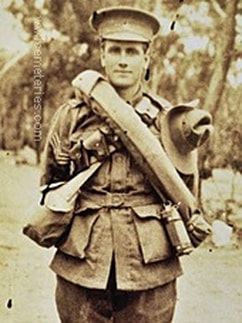
20217 Sergeant
Clarence Gordon Ranson, M. M.
27th Bty. 7th Bde. Australian Field Artillery
16th October 1917
Plot I. L. 26.
From Scotsdale, Tas. A bushman prior to enlisting in November 1915, Clarence Ranson embarked with the 8th Field Artillery Brigade, Brigade Ammunition Column, from Melbourne on board HMAT Medic (A7) on 20 May 1916. He arrived in France for service on the Western Front on 24 November 1916. He was promoted to the rank of Sergeant (Sgt) on 1 January 1917. On the night of 7/8 June 1917, near Ploegsteert, Belgium, while the nearby area was being heavily shelled, Sgt Ranson saved six members of an infantry unit from a gas attack. He provided aid and suceeded in getting all to a dressing station. Afterwards, Sgt Ransom suffered the effects of the gas. For his actions he was awarded the Military Medal (MM) on 24 May 1917. Sgt Ranson was killed in action at Passchendaele, Belgium.
Clarence Gordon Ranson, M. M.
27th Bty. 7th Bde. Australian Field Artillery
16th October 1917
Plot I. L. 26.
From Scotsdale, Tas. A bushman prior to enlisting in November 1915, Clarence Ranson embarked with the 8th Field Artillery Brigade, Brigade Ammunition Column, from Melbourne on board HMAT Medic (A7) on 20 May 1916. He arrived in France for service on the Western Front on 24 November 1916. He was promoted to the rank of Sergeant (Sgt) on 1 January 1917. On the night of 7/8 June 1917, near Ploegsteert, Belgium, while the nearby area was being heavily shelled, Sgt Ranson saved six members of an infantry unit from a gas attack. He provided aid and suceeded in getting all to a dressing station. Afterwards, Sgt Ransom suffered the effects of the gas. For his actions he was awarded the Military Medal (MM) on 24 May 1917. Sgt Ranson was killed in action at Passchendaele, Belgium.
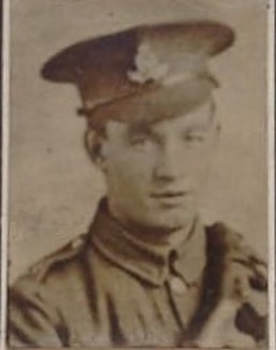
695690 Driver
Robert Robinson
59th Division. Ammunition Column. Royal Field Artillery
30th September 1917, aged 26.
Plot I. J. 27.
Son of Joseph Robinson; husband of Catherine Robinson, of 18, Upper Milk St., Liverpool.
Bob was born and lived in Scotland Road, Liverpool and worked as as Stonemason.
Remembered by his Great Grandson Peter Richards
Robert Robinson
59th Division. Ammunition Column. Royal Field Artillery
30th September 1917, aged 26.
Plot I. J. 27.
Son of Joseph Robinson; husband of Catherine Robinson, of 18, Upper Milk St., Liverpool.
Bob was born and lived in Scotland Road, Liverpool and worked as as Stonemason.
Remembered by his Great Grandson Peter Richards
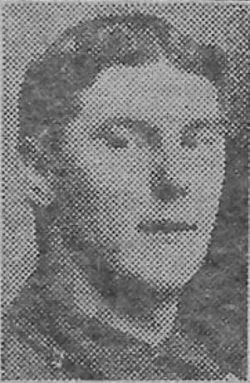
9204 Sergeant
Thomas Henry Sanderson, D. C. M. &. M. M.
"C" Battery, 71st Brigade, Royal Field Artillery
17th August 1917, aged 26.
Plot II. F. 12.
Son of Thomas Mounsey Sanderson and Mary Sanderson, of Grasmere, Westmorland; husband of Mrs. Sanderson, of 13, Ashworth St., Dalton-in-Furness, Lancs.
His headstone bears the inscription "Peace Perfect Peace"
Newspaper Article courtesy of John Lindsay
Thomas Henry Sanderson, D. C. M. &. M. M.
"C" Battery, 71st Brigade, Royal Field Artillery
17th August 1917, aged 26.
Plot II. F. 12.
Son of Thomas Mounsey Sanderson and Mary Sanderson, of Grasmere, Westmorland; husband of Mrs. Sanderson, of 13, Ashworth St., Dalton-in-Furness, Lancs.
His headstone bears the inscription "Peace Perfect Peace"
Newspaper Article courtesy of John Lindsay
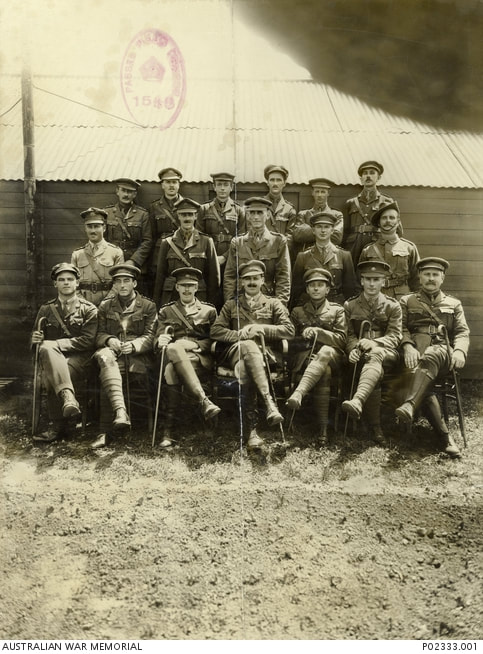
Brandhoek, Belgium, c. June 1917. Outdoors group portrait of the officers and Regimental Sergeant Major (RSM) of the 1st Australian Tunnelling Company at a camp near Poperinghe. The men are (left to right): back row: Lieutenant (Lt) Cyril Henry Clayton; 2nd Lieutenant (2Lt) Robert John Finlayson, accidentally killed 25th June 1917; Lt John MacDiarmid Royle; Captain (Capt) Donald Yates, MC; Lt Samuel James Lindsay; Lt ? John Edward Armstrong. Second row: Lt S.H. Jones; Lt Henry David Hill; Lt Walter Moore; Lt James Bowry; 3521 RSM Walter George Lyne. Front row: Capt Ronald Butler Hinder, MC; Capt Robert Adam Clinton, MC; Capt (later Major) Ernest Sleeman Anderson; Major James Douglas Henry, CO, OBE, DSO; Capt Oliver Holmes Woodward, MC and two bars; Lt Hubert Henry Carroll, MC; Lt Willoughby Manton, MC.

